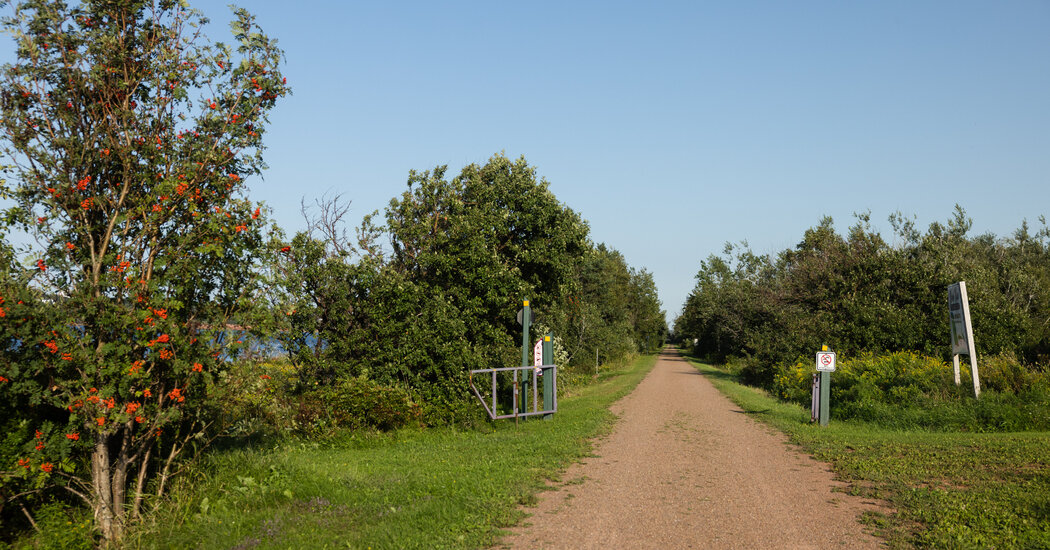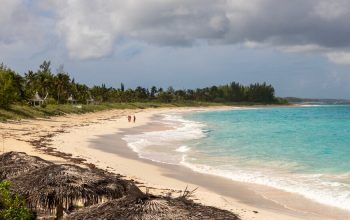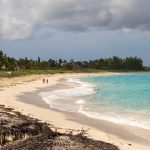Never underestimate the difficulty of a flat trail over a great distance. After my first five-hour day following the Island Walk, a new 435-mile trail that rings Prince Edward Island, in Canada’s smallest province, I limped into Points East Coastal Inn in bayside St. Peter’s Bay with a blister cooking on my right sole and a paralyzing need to rest barefoot until checkout the next morning.
A veteran of the Camino de Santiago, the long-distance pilgrimage trail through northern Spain, I had done this sort of thing before. But like all travel-related hassles that I relegate to the trash bin of my memory — flight delays, security searches, sand flies at the beach — I had forgotten about the relentless demands of walking when your feet throb and the scenery barely changes in the course of a day. I had forgotten what a walking meditation feels like.
Returning from the Camino in 2016, Bryson Guptill, an island resident who founded the walk, thought, “Why not here?” he told me as I rested shoeless that June afternoon on the inn’s porch. “It’s an island and you can walk in a big circle, when none of these long-distance walks are circular. And you’ve got shoreline with great vistas no matter what part of the island you’re on.”
Designed largely by linking existing trails and roads, the Island Walk was set to debut in 2020 when the pandemic struck. It finally opened in August 2021, and attracted about 50 walkers that year. Late in 2022, Hurricane Fiona, a Category 4 storm, ravaged the island, destroying an estimated 40 percent of its trees, wreckage that made parts of the trail impassable.
This year, 300 people have registered on the walk’s website.
“The challenge in P.E.I. is it’s not a large population and you’re basically walking to rural areas,” Mr. Guptill said, noting that about half of the trail’s 32 way points or sections, which are roughly 12 to 15 miles apart, don’t offer handy accommodations.
He believes that will change in the coming years. Already, since the walk’s opening, there are new hostel accommodations at Ned’s Landing at Spry Point, southeast of Charlottetown, the capital. Bus service has expanded in rural areas, helping walkers travel to way points. The tour company Experience PEI coordinates walking routes (starting at 350 Canadian dollars, or about $260, for seven days). D.I.Y. walkers can book shuttles between the trail and lodgings through Bill’s Van Service and Cycling Tours PEI.
Lodging, shuttles and food add up. Cost estimates for walking the trail range from about 170 dollars a day to 5,000 or 6,000 dollars for the month required to complete it, according to users of the Island Walk’s active Facebook group.
“The Island Walk’s success is way ahead of the infrastructure,” said Sarah Branje, one of the owners of Points East Coastal Inn, during my stay.
Laura MacGregor, 55, of Waterloo, Ontario, did the complete walk last summer from her camper, which she moved periodically, relying on Experience PEI shuttles to run her back and forth to the trail. She spent about 5,000 dollars over the month.
“For me, as for many who do long-distance pilgrimages, it was an opportunity to engage in significant personal reflection,” said Ms. MacGregor, who lost a child during the pandemic.
A slow-travel enthusiast with limited time, I took a piecemeal approach to the logistical puzzle. I planned five days on the east end, which is peppered with small inns, and set out in the virtual company of the Canadian actress Rachel McAdams, narrator of an audio version of “Anne of Green Gables,” the 1908 novel of a spirited orphan and probably Prince Edward Island’s most famous export.
Walking inn to inn
After a day of planes and buses, I arrived in Mount Stewart, roughly 17 miles from Charlottetown, in the late afternoon to walk to my first inn, Bishop’s Rest in St. Andrews.
Wide enough for a car, the flat, red gravel Island Walk path passed wetlands, where I flushed out three wood ducks. Red-winged blackbirds sang out my approach, and warblers foraged in wild apple trees amid stands of birch, maple and pine that occasionally thinned to reveal freshly plowed red dirt fields beyond.
Within 40 minutes, a sign pointed to Bishop’s Rest, about 400 yards off the route on a grassy path bordered by blooming chokecherry shrubs. The hilltop 1890 colonial home once housed priests from the neighboring church. Now Sarah Charlton, a high school English teacher, and her husband, Ben, a chef, operate it as a three-bedroom bed-and-breakfast (I paid 160 dollars, including breakfast). About five years ago they added meals for guests.
“We get a lot of walkers and cyclists, and there’s nothing around here,” said Ms. Charlton, as she served her husband’s indulgent seafood chowder (19 dollars), loaded with local mussels, scallops, fish and lobster, at dinner.
Among trail sections, the roughly 17-mile stretch from Mount Stewart to St. Peter’s Bay is purportedly among the most scenic, tunneling through forests and emerging at a broad bay filled with mussel farms identified by grids of buoys in the placid water.
Signposted every kilometer, the trail doubled as a sound bath of singing birds and twangy frogs. I spotted goldfinches, hairy woodpeckers and, in the fields, bee boxes. Wild strawberries grew on the side of the trail. Abundant mosquitoes ensured I didn’t lollygag at picnic shelters.
According to “Anne of Green Gables,” “In Prince Edward Island, you were supposed to nod to all and sundry you meet on the road, whether you know them or not.” Resident passers-by advanced beyond nodding, stopping me to ask about my trip and offer local advice. A power-walking couple recommended the Seafood Shack in nearby Morell for lunch. A woman walking her pit bull showed me a resident garter snake at a creek. I asked a five-man crew from the transportation department clearing out beaver dams how they managed the mosquitoes. They laughed, saying they were immune, and offered me their bug repellent.
Five hours and one blister later, I checked into Points East Coastal Inn (rooms from 169 dollars, including breakfast), an 1870s-era home with a mansard roof and a shady porch that Rodger and Sarah Branje, Ontario transplants, operate as a three-room bed-and-breakfast, providing a warm welcome and unexpected luxuries such as bathrobes, slippers and mini-refrigerators stocked with sodas and water.
Restaurants in the tiny town of St. Peter’s Bay, gateway to the coastal Greenwich section of Prince Edward Island National Park, remained closed in mid-June, prompting the innkeepers to offer to pick up takeout from a restaurant in a neighboring town. But the next morning’s generous breakfast — featuring fruit salad, yogurt, homemade muffins, and entree choices that included pancakes and eggs benedict — more than fortified me for another day on the trail.
Depth over range
If blisters are a physical hurdle for walkers, ambition is a mental one. With about 14 miles ahead on Day 3, frustration set in as I had to leave St. Peter’s Bay without seeing the national park, which is not on the trail. Walking favors depth over range, I consoled myself, as I watched a flock of cedar waxwings perched in a tree just an arm’s length away.
“That’s the trouble, isn’t it?” said a cyclist from Australia I met on the trail. “You can’t get everything in, but then you don’t get this,” she added, opening her arms to tranquil Larkins Pond, where a pair of cinnamon teals paddled from the reeds. “The smells, the sounds.”
A soaking rain picked up just before I reached New Zealand — more of a crossroads than a town — where Mellanie Stephens, who owns the Johnson Shore Inn with her partner, Dave Dixon, picked me up for the eight-minute ride to their 10-room oceanfront hotel (rooms from 175 dollars, including breakfast).
From Room 7, relieved to recover in warmth, I had a view of the property’s 30-foot red cliffs. Dozens of lobster buoys bobbed in the water, and a meadowlark sang out on the broad lawn. As at Points East, once I sat down, I had no desire to leave and was grateful for an inn with meals.
“I hope you like pork,” said Ms. Stephens, pouring me a glass of white wine before dinner (40 to 60 dollars) to go with her pork tenderloin, roasted potatoes and asparagus.
Embracing solitude
Four days into the walk, I found my rhythm. My legs became accustomed to hours of walking, and I worried less about transfers, food and cellular service, all of which had been reliable. By 8:30 a.m., the Johnson Shore innkeepers had driven me back to the trail, leaving plenty of time to walk to the town of Elmira to catch my next hotel shuttle at 2:30 p.m.
If you like solitude, do the Island Walk. On this, my quietest day, I met only one other party, three birders who directed me to kilometer 260, where they had counted 15 different species of warblers, and I spotted one spectacular orange-throated Blackburnian warbler. Down the path, a pileated woodpecker chortled. Later, the trail was so deserted that I managed to surprise a red fox, who scampered up a bank and back into the woods. As maples bent across the path, forming a tunnel, the titular heroine of “Anne of Green Gables” observed, through the audiobook, “Maples are such sociable trees. They’re always rustling and whispering to you.”
I had time to stretch my achy quads and calves beside the former Elmira train station, now a museum, as I waited for the shuttle from Siren’s Beach Motel, a tidy, bright blue, 12-room motel just a dune away from the beach in the east-end town of North Lake (rooms from 195 dollars).
Craving company, I was thrilled to share the ride with two other walkers — Canadian doctors and lifelong friends in their 60s — with whom I put in an additional two miles on foot exploring the fishing port as deckhands unloaded lobster boats.
Later we dined on buttery lobster rolls at North Lake Boathouse Eatery beside Siren’s, where a waitress showed us videos on her phone of Setting Day, the first day of lobster season, when a bagpiper played the boats out of the harbor.
Beach finale
In the morning, I followed the murmurs of boats to the beach and counted 29 on the horizon. After a breakfast sandwich at the restaurant, my fellow walkers and I got a lift down the road to way point 23 at Bothwell, skipping the one-day walk there in favor of finishing up on the south coast beach at Basin Head Provincial Park.
We set out toward the shore on a red dirt road that dipped and rolled through farm fields toward the dunes. At the shore, we turned west to walk into the park, known for its “singing sands,” which contain a high quantity of silica that makes a squeaky sound when walked on. At least when it’s dry. Damp from an overnight rain, the sand didn’t sing, but pods of foraging porpoises surfaced offshore and more than made up for it as a scenic farewell to the Island Walk, just as I began to enjoy it.
Follow New York Times Travel on Instagram and sign up for our weekly Travel Dispatch newsletter to get expert tips on traveling smarter and inspiration for your next vacation. Dreaming up a future getaway or just armchair traveling? Check out our 52 Places to Go in 2023.







